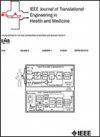Electroencephalography-Based Recognition of Low Mental Resilience Using Multi-Condition Decision-Level Fusion Approach
IF 4.4
3区 医学
Q2 ENGINEERING, BIOMEDICAL
IEEE Journal of Translational Engineering in Health and Medicine-Jtehm
Pub Date : 2025-08-08
DOI:10.1109/JTEHM.2025.3597088
引用次数: 0
Abstract
Background: Mental resilience is an important indicator of our defence mechanism against mental illness. The assessment of mental resilience is conventionally done using psychological questionnaires but more recently, has been investigated using neuroimaging modalities such as the Magnetic Resonance Imaging and Positron Emission Tomography. While having high spatial resolution, these modalities might not be cost-effective and accessible to serve larger populations. This pilot trial investigates the performance of electroencephalography (EEG) based system to assess mental resilience under different mental conditions.Methods: A total of sixty-eight healthy adults took part in this trial. Three types of EEG features, namely spectra, functional connectivity (FC) and effective connectivity (EC) were extracted, and their correlation with a standard resilience assessment instrument – the Connor-Davidson Resilience Scale were evaluated at resting and task conditions using stepwise regression. The features with the best goodness of fit model were then used to classify individuals into a low and high mental resilience class.Results: The EC features using phase slope index achieved the highest adjusted基于脑电图的低心理弹性多条件决策融合识别
背景:心理弹性是心理疾病防御机制的重要指标。心理弹性的评估传统上是通过心理问卷来完成的,但最近,已经使用神经成像方式进行了研究,如磁共振成像和正电子发射断层扫描。这些模式虽然具有高空间分辨率,但可能不具有成本效益,无法为更大的人口提供服务。本试验旨在研究基于脑电图(EEG)的心理弹性评估系统在不同心理状态下的表现。方法:共有68名健康成人参加了这项试验。提取三种EEG特征,即频谱、功能连通性(FC)和有效连通性(EC),并在静息和任务条件下用逐步回归方法评估其与标准弹性评估工具- Connor-Davidson弹性量表的相关性。然后利用最佳拟合优度模型的特征将个体分为低心理弹性和高心理弹性两类。结果:与光谱特征和FC特征相比,采用相斜率指数的EC特征获得了最高的调整后R^{2}$和最低的均方根误差。使用EC特征训练的SVM分类器能够识别低心理弹性,根据心理状况,准确率至少为66%。将闭眼、睁眼和任务条件的SVM评分融合后,分类准确率达到85%以上。结论:前导试验揭示了脑电作为评估心理弹性最具前景的脑电特征类型,因为它可以测量大脑活动的因果关系,并证明了不同心理状态下的决策融合有助于提高对低心理弹性的识别。该试验的结果有助于完善基于脑电图的工作场所弹性评估系统。临床影响-直接评估使用脑成像模式,如脑电图提供了一种经济有效的手段来评估心理弹性。据我们所知,这是对健康受试者的首次尝试。通过识别出的神经标记,该解决方案展示了融合不同心理状态的脑电图特征的潜力,从而在工作场所环境中提供准确的心理弹性评估。
本文章由计算机程序翻译,如有差异,请以英文原文为准。
求助全文
约1分钟内获得全文
求助全文
来源期刊

IEEE Journal of Translational Engineering in Health and Medicine-Jtehm
Engineering-Biomedical Engineering
CiteScore
7.40
自引率
2.90%
发文量
65
审稿时长
27 weeks
期刊介绍:
The IEEE Journal of Translational Engineering in Health and Medicine is an open access product that bridges the engineering and clinical worlds, focusing on detailed descriptions of advanced technical solutions to a clinical need along with clinical results and healthcare relevance. The journal provides a platform for state-of-the-art technology directions in the interdisciplinary field of biomedical engineering, embracing engineering, life sciences and medicine. A unique aspect of the journal is its ability to foster a collaboration between physicians and engineers for presenting broad and compelling real world technological and engineering solutions that can be implemented in the interest of improving quality of patient care and treatment outcomes, thereby reducing costs and improving efficiency. The journal provides an active forum for clinical research and relevant state-of the-art technology for members of all the IEEE societies that have an interest in biomedical engineering as well as reaching out directly to physicians and the medical community through the American Medical Association (AMA) and other clinical societies. The scope of the journal includes, but is not limited, to topics on: Medical devices, healthcare delivery systems, global healthcare initiatives, and ICT based services; Technological relevance to healthcare cost reduction; Technology affecting healthcare management, decision-making, and policy; Advanced technical work that is applied to solving specific clinical needs.
 求助内容:
求助内容: 应助结果提醒方式:
应助结果提醒方式:


